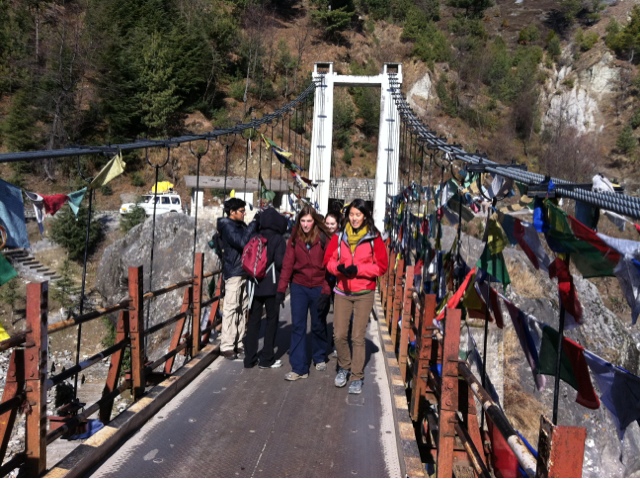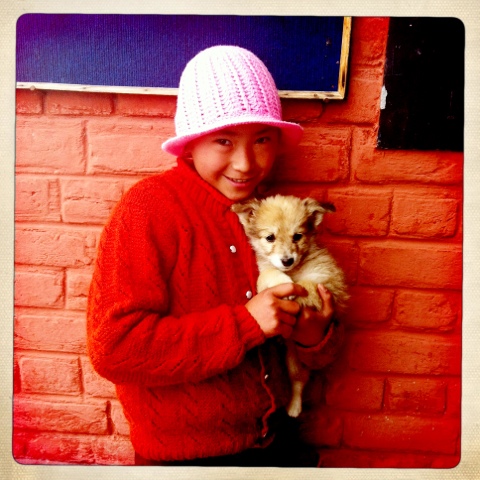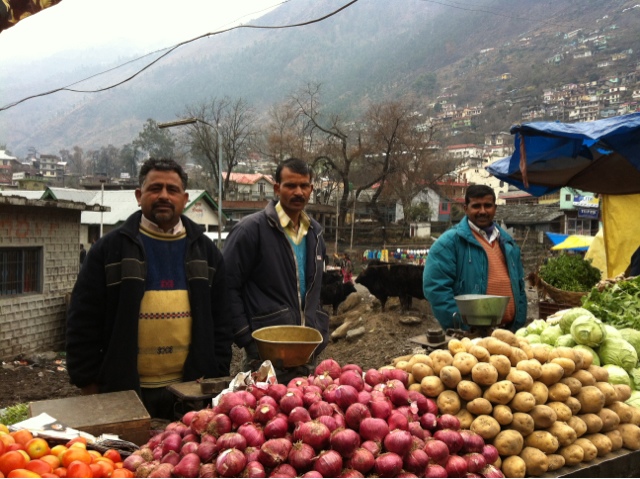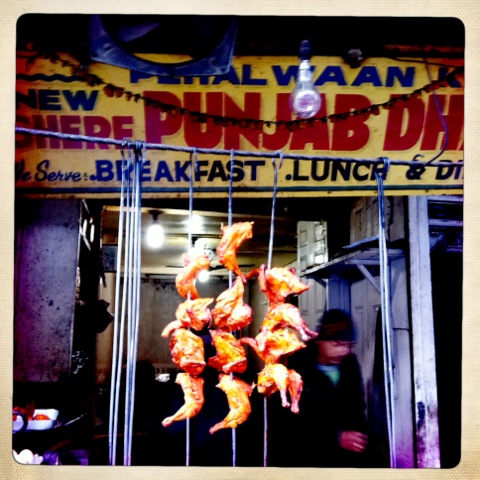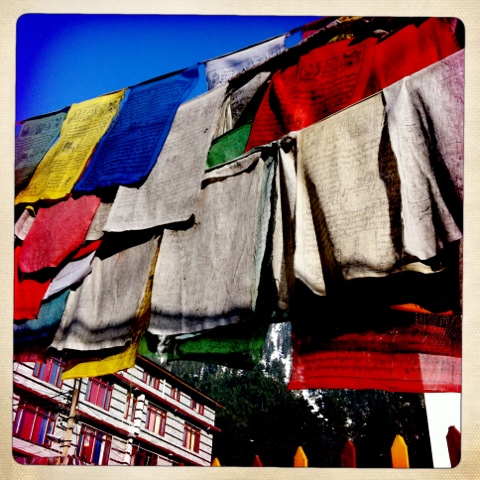14-18 February 2012
Tents, Pit Toilets and Bovine Neighbors
It was a long drive from the Dhakpo monastery to the campsite where we would spend the next five nights. We slowly descended through the Kullu valley to a lower elevation, eventually ending up on road that circled the perimeter of a large reservoir. After about 4 hours of driving, the caravan of cars stopped at a pedestrian only suspension bridge and we got out and walked the last mile to the campsite.
We could see our bright yellow tents from afar; they were set up in a neat row near the bank of the reservoir. The campsite was located about 500 feet below the level of the road. We all carried our heavy bags and suitcases down a narrow dusty trail, pausing to let a herd of cows pass us. I was thankful to have a backpack I could carry easily on my back instead of a suitcase. It was humorous to watch some of the others attempt to wheel their suitcases down the trail.
It was a beautiful afternoon, and we all settled into the campsite. I was pleased that the weather at this lower elevation was at least 10 degrees higher. Feeling quite sedentary, Karen and I decided to do some strength training like sprints, squats and push-ups on the edge of the water. It was great to feel hot and sweaty instead of numb and shivering.
Throughout the course of our five night stay we worked four clinics. The first was about a 45 minute drive away in a more remote section of the valley. It was a beautiful site, surrounded by terraced fields and stone and thatched roof buildings. The weather was gorgeous that day and we sat outside as we interviewed our patients. There was a brief interruption of our clinic when a big local politician arrived for a rally. There were firecrackers, horns and lots of fanfare. The patients and our translator all momentarily left to listen to the speech.
I had quite a few interesting gynecological cases that day instead of predominantly primary care issues. At the end of the day, we were even sent a male patient. This was the first time I had seen a penis, in a medical setting, since medical school. I quickly called Max, the ER resident, over for a consultation about the man's penile lesion-I was way out of my league there.
The second clinic was located 40 minutes away in an even tinier town than the first one. Our examination tents were set up next to a small farm lot. We ate lunch on the roof top of a box-like building. I was really getting spoiled on the concept of an outdoor clinic--seeings patients while basking in the sunlight. Why can't we do this at home?
The other two clinics were located at a school within walking distance of our campsite just near the foot bridge we had crossed on the first day. The school site offered a great view of the reservoir and valley as it was set higher above the level of the water. The school children were very curious about us the first day. The giggled and posed for pictures, clearly we had distracted them from learning. My gynecology exam table was placed in a dark smokey room the size of a closet. The room was normally used as a kitchen and it had no electricity so we needed a camping headlamp to do exams.
On that day, our group provided a lunch for all of the school children and locals who visited the clinic. A man had come down from one of the local Hindu temples to help prepare the meal and was wearing a special outfit. I spent awhile in the "kitchen" which was just an abandoned building, watching the meal preparations. When lunchtime finally arrived, the children sat on the ground, neatly lined up in rows. They were served heaping mounds of rice, at least the amount of 4 servings. They were also given lentils, a fried yogurt dish, and a salad. Many of them had seconds. It was probably one of the largest meals they had had in a long time. It was also apparent why most of them had vitamin deficiencies and cavities from their unbalanced high glycemic index carbohydrate-laden diet.
The second day of our clinic at the school site, we had a small turnout of patients. The villagers told us that there had been a suicide in one of the nearby towns. A 23 year old man had hung himself and they'd found him that morning. He had a one year old child. They were preparing for his cremation. When there was downtime in the afternoon, the children performed a song and dance routine for us. Apparently it was a dance that is often done at Indian weddings. In return, they asked us to perform for them. Mandy, Karen, and Jess did some kind of aerobic dance routine for them to the tune of some '90's music playing on an iPhone.
In the afternoons and evenings, we got creative with different ways to entertain ourselves. For some people, I think it was difficult to feel entertained without television or internet so a few resorted to drinking cheap vodka and rum in their tents or by the water.
During the afternoons, we might sit around on our camping stools, reading our respective books. It was refreshing to finally be able to spend time reading a book for pleasure and not for study. One afternoon, half a dozen of us visited the local Hindu temple where a man in some sporty sunglasses gave us a blessing. The blessing consisted of some orange paint on our foreheads, sweet water to drink (or in our case, pretend to drink), flower petals, and sugary sweet rice puffs. There was usually an afternoon cricket game being played in the large field by our tents. The Americans were learning how to play the game from Ravi, the drivers, and the local kids. Karen and I did yoga one afternoon by the water. Another day, Jess and I went for a run along the main road. In a matter of 2 weeks, I had already lost a lot of endurance and what would have normally been a simple 5 mile run turned into a challenging event. The hill climbs didn't help either.
There were Hearts and other card game tournaments. Some people went into the kitchen tent and helped the cooks prepare the night's meal. One night we celebrated one of the medical student's, Shaneel's, birthday. Ravi had brought birthday cake mix from the US and the cooks did a good job preparing the cake in their rudimentary propane-powered oven. We drank beer and played music in our dinner tent and even had a little dance party.
There were periodic visitors to our campsite, both human and animal. Besides the boys coming for a cricket game, some of the other villagers would also walk through the campsite, curiously looking at our tents. Many times they were in the process of herding cattle. Other times, the cows showed up alone; they didn't do much besides stand there and poop. A few dogs took a liking to us, in fact one shaggy black dog ran along with Jess and me while we went out on our run. He was a very good companion. There was a little girl with a unibrow who we spotted many times at our site. Sometimes she was collecting sticks, other times she was kicking cow piles around. She always seem to show up out of nowhere, it was actually kind of creepy. She seemed a little "off." Max was even a bit frightened.
I enjoyed the camping experiences, overall, but was also glad to go back to some of the daily "luxuries" that we take for granted at home. I had not had a proper shower in about six days. Our version of a bath or shower was a large bucket of hot water in a "shower tent." It was difficult to even get all of the soap off of the body, it was cold, and at the end, there was dirt and grass on my feet. I had gotten used to squatting over a pit toilet, also known as a dirt hole, to go to the bathroom, but my knees were starting to feel sore. There is something wonderful about a proper western toilet.
Tents, Pit Toilets and Bovine Neighbors
It was a long drive from the Dhakpo monastery to the campsite where we would spend the next five nights. We slowly descended through the Kullu valley to a lower elevation, eventually ending up on road that circled the perimeter of a large reservoir. After about 4 hours of driving, the caravan of cars stopped at a pedestrian only suspension bridge and we got out and walked the last mile to the campsite.
We could see our bright yellow tents from afar; they were set up in a neat row near the bank of the reservoir. The campsite was located about 500 feet below the level of the road. We all carried our heavy bags and suitcases down a narrow dusty trail, pausing to let a herd of cows pass us. I was thankful to have a backpack I could carry easily on my back instead of a suitcase. It was humorous to watch some of the others attempt to wheel their suitcases down the trail.
It was a beautiful afternoon, and we all settled into the campsite. I was pleased that the weather at this lower elevation was at least 10 degrees higher. Feeling quite sedentary, Karen and I decided to do some strength training like sprints, squats and push-ups on the edge of the water. It was great to feel hot and sweaty instead of numb and shivering.
Throughout the course of our five night stay we worked four clinics. The first was about a 45 minute drive away in a more remote section of the valley. It was a beautiful site, surrounded by terraced fields and stone and thatched roof buildings. The weather was gorgeous that day and we sat outside as we interviewed our patients. There was a brief interruption of our clinic when a big local politician arrived for a rally. There were firecrackers, horns and lots of fanfare. The patients and our translator all momentarily left to listen to the speech.
I had quite a few interesting gynecological cases that day instead of predominantly primary care issues. At the end of the day, we were even sent a male patient. This was the first time I had seen a penis, in a medical setting, since medical school. I quickly called Max, the ER resident, over for a consultation about the man's penile lesion-I was way out of my league there.
The second clinic was located 40 minutes away in an even tinier town than the first one. Our examination tents were set up next to a small farm lot. We ate lunch on the roof top of a box-like building. I was really getting spoiled on the concept of an outdoor clinic--seeings patients while basking in the sunlight. Why can't we do this at home?
The other two clinics were located at a school within walking distance of our campsite just near the foot bridge we had crossed on the first day. The school site offered a great view of the reservoir and valley as it was set higher above the level of the water. The school children were very curious about us the first day. The giggled and posed for pictures, clearly we had distracted them from learning. My gynecology exam table was placed in a dark smokey room the size of a closet. The room was normally used as a kitchen and it had no electricity so we needed a camping headlamp to do exams.
On that day, our group provided a lunch for all of the school children and locals who visited the clinic. A man had come down from one of the local Hindu temples to help prepare the meal and was wearing a special outfit. I spent awhile in the "kitchen" which was just an abandoned building, watching the meal preparations. When lunchtime finally arrived, the children sat on the ground, neatly lined up in rows. They were served heaping mounds of rice, at least the amount of 4 servings. They were also given lentils, a fried yogurt dish, and a salad. Many of them had seconds. It was probably one of the largest meals they had had in a long time. It was also apparent why most of them had vitamin deficiencies and cavities from their unbalanced high glycemic index carbohydrate-laden diet.
The second day of our clinic at the school site, we had a small turnout of patients. The villagers told us that there had been a suicide in one of the nearby towns. A 23 year old man had hung himself and they'd found him that morning. He had a one year old child. They were preparing for his cremation. When there was downtime in the afternoon, the children performed a song and dance routine for us. Apparently it was a dance that is often done at Indian weddings. In return, they asked us to perform for them. Mandy, Karen, and Jess did some kind of aerobic dance routine for them to the tune of some '90's music playing on an iPhone.
In the afternoons and evenings, we got creative with different ways to entertain ourselves. For some people, I think it was difficult to feel entertained without television or internet so a few resorted to drinking cheap vodka and rum in their tents or by the water.
During the afternoons, we might sit around on our camping stools, reading our respective books. It was refreshing to finally be able to spend time reading a book for pleasure and not for study. One afternoon, half a dozen of us visited the local Hindu temple where a man in some sporty sunglasses gave us a blessing. The blessing consisted of some orange paint on our foreheads, sweet water to drink (or in our case, pretend to drink), flower petals, and sugary sweet rice puffs. There was usually an afternoon cricket game being played in the large field by our tents. The Americans were learning how to play the game from Ravi, the drivers, and the local kids. Karen and I did yoga one afternoon by the water. Another day, Jess and I went for a run along the main road. In a matter of 2 weeks, I had already lost a lot of endurance and what would have normally been a simple 5 mile run turned into a challenging event. The hill climbs didn't help either.
There were Hearts and other card game tournaments. Some people went into the kitchen tent and helped the cooks prepare the night's meal. One night we celebrated one of the medical student's, Shaneel's, birthday. Ravi had brought birthday cake mix from the US and the cooks did a good job preparing the cake in their rudimentary propane-powered oven. We drank beer and played music in our dinner tent and even had a little dance party.
There were periodic visitors to our campsite, both human and animal. Besides the boys coming for a cricket game, some of the other villagers would also walk through the campsite, curiously looking at our tents. Many times they were in the process of herding cattle. Other times, the cows showed up alone; they didn't do much besides stand there and poop. A few dogs took a liking to us, in fact one shaggy black dog ran along with Jess and me while we went out on our run. He was a very good companion. There was a little girl with a unibrow who we spotted many times at our site. Sometimes she was collecting sticks, other times she was kicking cow piles around. She always seem to show up out of nowhere, it was actually kind of creepy. She seemed a little "off." Max was even a bit frightened.
I enjoyed the camping experiences, overall, but was also glad to go back to some of the daily "luxuries" that we take for granted at home. I had not had a proper shower in about six days. Our version of a bath or shower was a large bucket of hot water in a "shower tent." It was difficult to even get all of the soap off of the body, it was cold, and at the end, there was dirt and grass on my feet. I had gotten used to squatting over a pit toilet, also known as a dirt hole, to go to the bathroom, but my knees were starting to feel sore. There is something wonderful about a proper western toilet.










